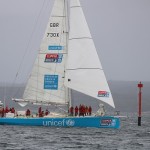 Clipper Unicef skipper Jim Prendergast has had medical treatment for kidney stones and has been temporarily replaced by Martin “Cloughy” Clough. It is sad that Jim will likely not be racing in the Hobart Race. We all wish him a speedy recovery and I hope to see him in Airlie Beach for the start of leg 5 to Da Nang and Qingdao.
Clipper Unicef skipper Jim Prendergast has had medical treatment for kidney stones and has been temporarily replaced by Martin “Cloughy” Clough. It is sad that Jim will likely not be racing in the Hobart Race. We all wish him a speedy recovery and I hope to see him in Airlie Beach for the start of leg 5 to Da Nang and Qingdao.
The fleet left Albany on Tuesday 1st December after a Parade of Sail while an aerobatic display was performed overhead. Apparently the bars and restaurants trebled their turnover and many of the hotels were fully booked. Another successful stopover performed by the teams.
Leg 4 consist of three races. The first, race 4 to Sydney which started on Tuesday is relatively short, 11 to 14 days, and is called the “Elliot Brown Timekeeper Cup”. During the race the fleet will be further south than during leg 3 from Cape Town to Albany, the rumb line will be close to the 40 degrees latitude. An area with fickly weather patterns, windy, cold and wet. But they will arrive in warm and sunny Sydney ready for Christmas.
Tzen Chia’s Blog Port time – Four evenings in Albany gives an insight in the importance of spending time on maintenance while ashore. An hour spend on maintenance is worth many hours solving problems at sea.
Henry’s blog explains about the temporary skipper replacement and the change in watch system. During training we always had a six hour on, six hours off during the day and then four hours on, four hours off during the night. The advantage is that the day and night watches alternate automatically and the night watches are shorter. It also gives the off-watch a good 6 hours relaxation and a decent 5 hours sleep. Up to Albany, Unicef had a four/four watch system and is now racing on a six/four watch system. It will be interesting to hear what the crew think of the advantages and disadvantages.
Yesterday Unicef crept up to third place, the highest position so far on this trip. Although this sounds impressive one needs to realise that the fleet is tightly packed with 3 to 20 miles between each pair. In this tight contest it only takes a minimal drop or improvement in boat speed to affect race positions. Da Nang – Viet Nam which was third yesterday is now tenth which sounds drastic though in reality it has only dropped about 20 nautical miles.
Today, Friday, Unicef has dropped a few places but, again, it is a very close pack and positions keep changing hour to hour. It is also interesting to see how the ranking compares with the race map showing the positions of the boats on the map. The positions are calculated by the distance to the next waypoint along the rumb line. A greater distance does not always translate in a later finish. The fleet is now moving north-east back towards the rumb line because of the easterly wind direction.
If you have checked the race map you may have noticed that a very strong competitor, LMAX Exchange, seem to have dropped way behind the others and is in last place. But, no, they are in “Stealth Mode”. Stealth Mode is a tactical card, which each team can play to hide their position from the rest of the fleet for the period of 24 hours. The Race Office team still track the team’s position every hour but their position is not displayed on the Race Viewer or sent to the fleet for the designated time. Stealth Mode does not have to be used by each team but can potentially give an advantage during a race, especially when the Skipper and navigators on board think they have spotted something in the weather reports that they think other teams may not have seen. So where are they going to pop-up tomorrow?
ETA (Estimated Time of Arrival) in Sydney is 12th to 15th December. Maybe we should call this EDA (Estimated Date of Arrival)?
Eleven days to go until my departure to Melbourne starting my own Round the World trip.

